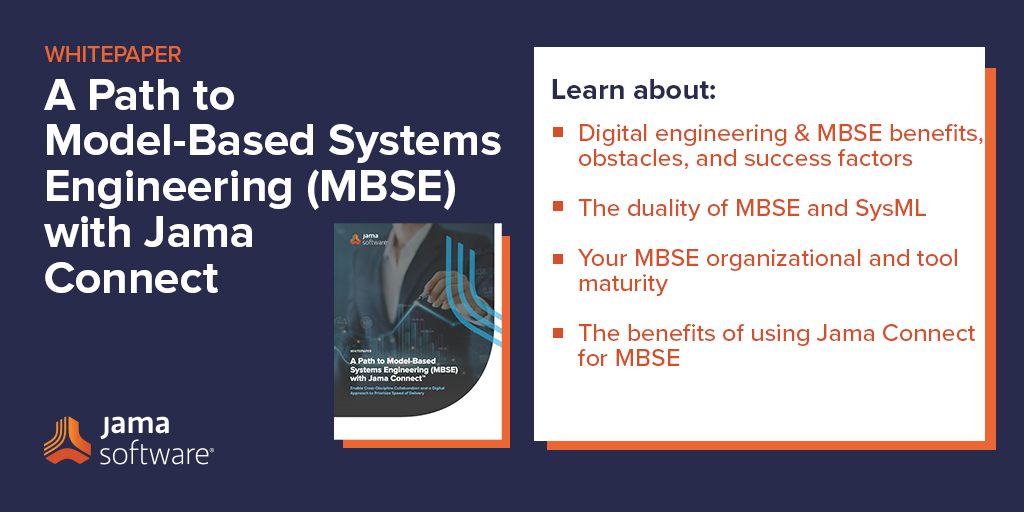The Digital Engineering Transformation
In today’s age of digital transformation, most product development teams are experiencing an issue of burgeoning software content causing immense effort and complexity to understand, write, design and validate, and produce. Digital engineering (DE) is a broader movement that takes shape in many industry segments such as medical device development, automotive, defense, consumer electronics, and aerospace to reduce the pains of developing new products, systems, and software. But, differences in maturity and methods sometimes make understanding the true state of DE difficult.
DE is an integrated approach that uses authoritative sources of system data and models (instead of documents) as a continuum across disciplines to support lifecycle activities — from concept through disposal. In the simplest of terms, it is the act of creating, capturing, and integrating data using models and innovative technology in an orchestrated manner in order to unlock greater value and provide positive impacts on cost and schedule. It is the system model for which MBSE is useful.
When developing avionics weapons systems, a document-based systems engineering process is inefficient and lacks an authoritative source of truth. Meeting the demands of modern development allows more teams to be connected to the design and engineering process. This allows everyone to have a clear understanding of the big picture and leads to better informed decision making, enhanced communication, increased understanding of and confidence in the system design, and a more efficient engineering process.
RELATED: How to Realign Engineering Teams for Remote Work with Minimal Disruption
Meeting Market Challenges and Managing Complexities with MBSE
Model-based systems engineering (MBSE) has been a popular topic in the systems engineering community for over a decade, but the level of movement or path towards implementation has not always been clear. Market forces are increasing the demand and urgency for organizations to implement the MBSE discipline across the enterprise.
Across industries including aerospace, transportation, industrial manufacturing, and healthcare, customer demand for new, complex, and interconnected products, systems, and software is ever-increasing — and these systems must now be smarter, safer, and more environmentally friendly — all while remaining affordable.
For teams using a cumbersome, and often disparate document-driven approach, facilitating a common understanding of complex systems across diverse stakeholders can often be problematic. To stay competitive, companies building these complex systems require a solution that reduces time and effort by providing an MBSE approach where the combination of collaboration, modeling, tools, and methods streamlines the end-to-end systems engineering process.
A good MBSE practice will prevent rework due to poorly developed requirements or lack of communication across engineering teams. It will help to eliminate risks by providing an architectural roadmap that makes it easier to visualize and provide validation checks.
Customers will be happy with the system delivered and report fewer complaints because the application of MBSE has enabled the teams to more easily perform requirements analysis and validation to ensure that what is being designed and built is solving the correct problems that the customer has.
To manage increasing complexity, engineers and stakeholders must use tools (like Jama Connect™) and techniques whose data is both human-readable and has the capability to integrate across the ecosystem. The challenge is having the ability to efficiently design and build as well as effectively collaborate across stakeholders with vastly different engineering disciplines (e.g., software, mechanical, materials, electrical, chemical, environmental). Each subsystem needs to interoperate with the others to achieve the expected system function, adhere to safety and/ or government regulations, and ultimately meet the customer’s requirements.
Download our new whitepaper, A Path to Model-Based Systems Engineering (MBSE) with Jama Connect, to learn more about digital engineering & MBSE benefits, obstacles, and success factors.
- FDA Issues Comprehensive Draft Guidance for Developers of Artificial Intelligence-Enabled Medical Devices - January 15, 2025
- 2025 Expert Predictions for Medical Device & Life Sciences: Innovations in Patient-Centered Care and the Future of Medical Device Design - January 9, 2025
- Jama Connect® Enables DevSecOps Through Robust API and Integrations That Connect All Activity to Requirements - January 7, 2025
